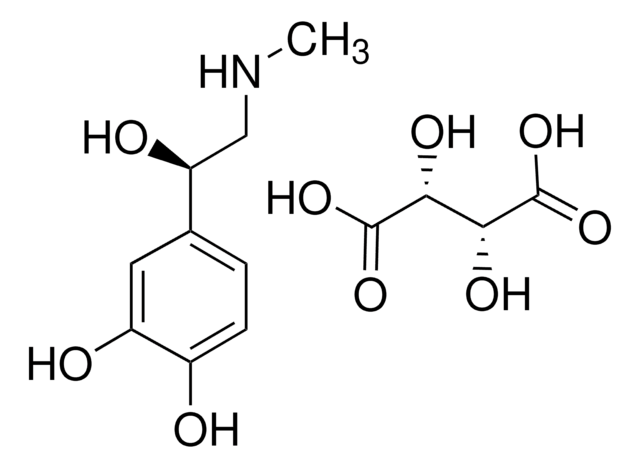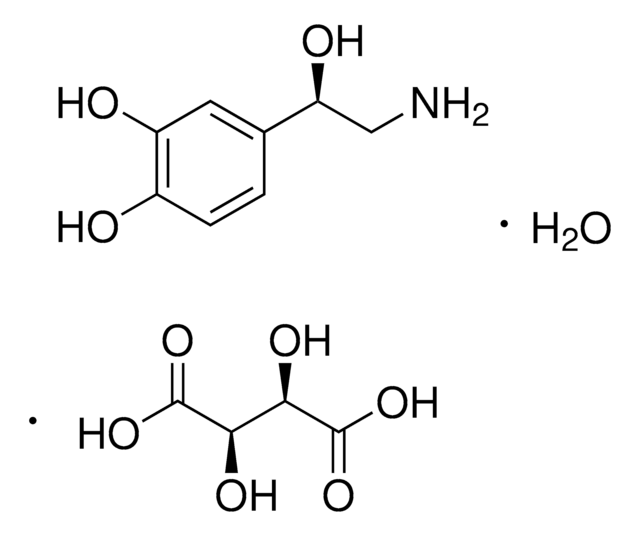A7257
(−)-Norepinephrine
≥98% (TLC), crystalline, adrenergic neurotransmitter
Sinonimo/i:
(R)-4-(2-Amino-1-hydroxyethyl)-1,2-benzenediol, L-Arterenol, L-Noradrenaline, Levarterenol
About This Item
Prodotti consigliati
Nome del prodotto
(−)-Norepinephrine, ≥98%, crystalline
Saggio
≥98%
Stato
crystalline
Colore
off-white to tan
Temperatura di conservazione
−20°C
Stringa SMILE
NC[C@H](O)c1ccc(O)c(O)c1
InChI
1S/C8H11NO3/c9-4-8(12)5-1-2-6(10)7(11)3-5/h1-3,8,10-12H,4,9H2/t8-/m0/s1
SFLSHLFXELFNJZ-QMMMGPOBSA-N
Informazioni sul gene
human ... ADRA1A(148) , ADRA1B(147) , ADRA1D(146) , ADRA2A(150) , ADRA2B(151) , ADRA2C(152) , ADRB1(153) , ADRB2(154) , ADRB3(155)
rat ... Adra1a(29412) , Adra1d(29413) , Adra2a(25083) , Adrb1(24925) , Adrb2(24176) , Drd1a(24316) , Drd2(24318)
Cerchi prodotti simili? Visita Guida al confronto tra prodotti
Categorie correlate
Descrizione generale
Applicazioni
- as anαand β-AR agonist to stimulate mouse organoids to study the pathways that are activated upon intestinal epithelial adrenergic receptor (AR) stimulation,
- to measure the monoamine levels in various limbic regions of mouse brains by high-performance liquid chromatography (HPLC) coupled with an electrochemical equipped with an auto-sampler,
- as a dispersal agent in biofilm dispersion assay to study its effects on the dispersal of Mannheimia haemolytica biofilms
Caratteristiche e vantaggi
Avvertenze
Danger
Indicazioni di pericolo
Consigli di prudenza
Classi di pericolo
Acute Tox. 1 Inhalation - Acute Tox. 2 Dermal - Acute Tox. 2 Oral
Codice della classe di stoccaggio
6.1B - Non-combustible acute toxic Cat. 1 and 2 / very toxic hazardous materials
Classe di pericolosità dell'acqua (WGK)
WGK 3
Dispositivi di protezione individuale
Eyeshields, Faceshields, Gloves, type P3 (EN 143) respirator cartridges
Scegli una delle versioni più recenti:
Certificati d'analisi (COA)
Non trovi la versione di tuo interesse?
Se hai bisogno di una versione specifica, puoi cercare il certificato tramite il numero di lotto.
Possiedi già questo prodotto?
I documenti relativi ai prodotti acquistati recentemente sono disponibili nell’Archivio dei documenti.
I clienti hanno visto anche
Protocolli
LC/MS/MS Analysis of Epinephrine, Metanephrine and Metabolites on Ascentis® Express OH5
Il team dei nostri ricercatori vanta grande esperienza in tutte le aree della ricerca quali Life Science, scienza dei materiali, sintesi chimica, cromatografia, discipline analitiche, ecc..
Contatta l'Assistenza Tecnica.











